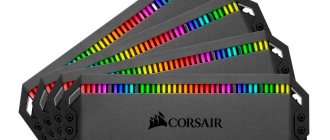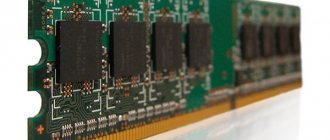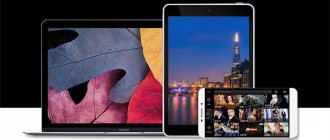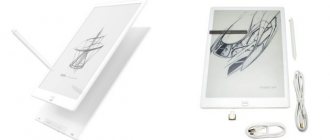General terminology TFT, PLS, IPS
First of all, it is necessary to clarify that TFT (thin film transistor technology) is used in all screens nowadays. Strictly speaking, both PLS and IPS operate using TFT technology on amorphous silicon transistors. Electric current hitting the liquid crystals sets the brightness, color and viewing angle of each pixel.
TN or TN+film is the first and now outdated type of TFT matrix, which had a very small viewing angle and insufficient brightness (contrast). TN screens did not react “calmly” enough to pressure, becoming covered with some ripples or waves, which is unacceptable for the screens of modern mobile devices.
PLS (Plane-to-Line Switching) and IPS (Super TFT) are modern and more advanced matrices used in monitors, TV screens and mobile devices.
A few words about liquid crystal displays
LCD (Liquid Crystal Display) is a display made from liquid crystals that change their location when voltage is applied to them. If you come close to such a display and look closely at it, you will notice that it consists of small dots - pixels (liquid crystals). In turn, each pixel consists of red, blue and green subpixels. When voltage is applied, the subpixels are arranged in a certain order and transmit light through them, thus forming a pixel of a certain color. Many such pixels form an image on the screen of a monitor or other device.
Technology from Hitachi
The basic Super TFT technology was developed in 1996 and did not have the disadvantages of TN:
- IPS is pressure resistant
- Much more “loyal” to the human eye and does not spoil vision as much
- Much brighter and more contrast, with a better viewing angle
Subsequently, several varieties of IPS were developed:
- S-IPS - successor to the base matrix, with increased response speed
- AS-IPS
- H-IPS
- IPS-Pro - consistently introduced technologies with increasingly improved brightness, contrast and viewing angle
- AFFS is a matrix with a significantly reduced distance between pixels. Used primarily in tablets
- e-IPS - cheaper matrix with reduced power consumption
- P-IPS is a matrix with a color depth of more than 30 bits. Screens based on it display more than a billion colors
- AH-IPS - simultaneously provides high brightness, contrast, viewing angle and energy savings.
LCD monitors
Now the technology of flat panel monitors, including liquid crystal monitors, is the most promising. Although LCD monitors currently account for only about 10% of sales worldwide, they are the fastest growing market sector (65% per year).
Principle of operation
LCD monitor screens (Liquid Crystal Display) are made of a substance (cyanophenyl) that is in a liquid state, but at the same time has some properties inherent in crystalline bodies. In fact, these are liquids that have anisotropy of properties (in particular optical ones) associated with order in the orientation of molecules. Oddly enough, liquid crystals are almost ten years older than CRTs; the first description of these substances was made back in 1888. However, for a long time no one knew how to use them in practice: there are such substances and everyone, and no one except physicists and chemists, they were not interesting. So, liquid crystal materials were discovered back in 1888 by the Austrian scientist F. Renitzer, but only in 1930 did researchers from the British Marconi corporation receive a patent for their industrial use. However, things did not go further than this, since the technological base at that time was still too weak. The first real breakthrough was made by scientists Fergason and Williams from RCA (Radio Corporation of America). One of them created a thermal sensor based on liquid crystals, using their selective reflective effect, the other studied the effect of an electric field on nematic crystals. And at the end of 1966, the RCA Corporation demonstrated a prototype LCD monitor - a digital clock. Sharp Corporation played a significant role in the development of LCD technology. It is still among the technology leaders. The world's first calculator CS10A was produced in 1964 by this corporation. In October 1975, the first compact digital watch was produced using TN LCD technology. In the second half of the 70s, the transition began from eight-segment liquid crystal displays to the production of matrices with addressing of each point. So, in 1976, Sharp released a black-and-white TV with a 5.5-inch screen diagonal, based on an LCD matrix with a resolution of 160x120 pixels. The operation of LCD is based on the phenomenon of polarization of the light flux. It is known that the so-called polaroid crystals are capable of transmitting only that component of light whose electromagnetic induction vector lies in a plane parallel to the optical plane of the polaroid. For the remainder of the light output, the Polaroid will be opaque. Thus, the Polaroid “sifters” the light, this effect is called polarization of light. When liquid substances were studied, the long molecules of which are sensitive to electrostatic and electromagnetic fields and are capable of polarizing light, it became possible to control polarization. These amorphous substances, due to their similarity to crystalline substances in electro-optical properties, as well as their ability to take the shape of a vessel, were called liquid crystals. Based on this discovery and through further research, it was possible to discover a connection between increasing the electrical voltage and changing the orientation of the crystal molecules to enable image creation. Liquid crystals were first used in displays for calculators and in electronic watches, and then they began to be used in monitors for laptop computers. Today, as a result of progress in this area, LCD displays for desktop computers are becoming increasingly common.
An LCD monitor screen is an array of small segments (called pixels) that can be manipulated to display information. An LCD monitor has several layers, where the key role is played by two panels made of sodium-free and very pure glass material called a substrate or substrate, which actually contain a thin layer of liquid crystals between them [see. rice. 2.1]. The panels have grooves that guide the crystals into specific orientations. The grooves are positioned so that they are parallel on each panel but perpendicular between two panels. Longitudinal grooves are obtained by placing thin films of transparent plastic on the glass surface, which is then specially processed. In contact with the grooves, the molecules in liquid crystals are oriented identically in all cells. Molecules of one of the varieties of liquid crystals (nematics), in the absence of voltage, rotate the vector of the electric (and magnetic) field in the light wave by a certain angle in the plane perpendicular to the axis of beam propagation. Applying grooves to the surface of the glass makes it possible to ensure the same angle of rotation of the plane of polarization for all cells. The two panels are located very close to each other. The liquid crystal panel is illuminated by a light source (depending on where it is located, liquid crystal panels work by reflecting or transmitting light).
The plane of polarization of the light beam rotates 90° when passing through one panel [see. rice. 2.2]. When an electric field appears, the molecules of liquid crystals partially line up vertically along the field, the angle of rotation of the plane of polarization of light becomes different from 90 degrees, and light passes through the liquid crystals unhindered [see Fig. rice. 2.3]. The rotation of the plane of polarization of the light beam is invisible to the eye, so it became necessary to add two more layers to the glass panels, which are polarizing filters. These filters transmit only that component of the light beam whose polarization axis corresponds to a given one. Therefore, when passing through a polarizer, the light beam will be weakened depending on the angle between its plane of polarization and the axis of the polarizer. In the absence of voltage, the cell is transparent, since the first polarizer transmits only light with the corresponding polarization vector. Thanks to liquid crystals, the polarization vector of the light is rotated, and by the time the beam passes to the second polarizer, it has already been rotated so that it passes through the second polarizer without problems [see. Fig. 2.4a].
In the presence of an electric field, the rotation of the polarization vector occurs at a smaller angle, thereby the second polarizer becomes only partially transparent to radiation. If the potential difference is such that the rotation of the plane of polarization in liquid crystals does not occur at all, then the light beam will be completely absorbed by the second polarizer, and the screen, when illuminated from behind, will appear black from the front (the backlight rays are completely absorbed in the screen) [see. Fig. 2.4b]. If you place a large number of electrodes that create different electric fields in separate places on the screen (cell), then it will be possible, with proper control of the potentials of these electrodes, to display letters and other image elements on the screen. The electrodes are placed in transparent plastic and can be of any shape. Technological innovations have made it possible to limit their dimensions to the size of a small dot; accordingly, a larger number of electrodes can be placed on the same screen area, which increases the resolution of the LCD monitor and allows us to display even complex images in color. To display a color image, the monitor needs to be backlit so that the light comes from the back of the LCD display. This is necessary so that the image can be viewed in good quality even if the surrounding environment is not bright. Color is produced by using three filters that separate three main components from the emission of a white light source. By combining the three primary colors for each point or pixel on the screen, it is possible to reproduce any color. In fact, in the case of color, there are several possibilities: you can make several filters one after another (leading to a small fraction of transmitted radiation), you can take advantage of the property of a liquid crystal cell - when the electric field strength changes, the angle of rotation of the polarization plane of the radiation changes differently for components of light with different wavelengths. This feature can be used to reflect (or absorb) radiation of a given wavelength (the problem is the need to accurately and quickly change the voltage). Which mechanism is used depends on the specific manufacturer. The first method is simpler, the second is more effective. The first LCD displays were very small, around 8 inches, while today they have reached 15" sizes for use in laptops, and 20" or larger LCD monitors are being produced for desktop computers. An increase in size is followed by an increase in resolution, which results in the emergence of new problems that were solved with the help of emerging special technologies; we will describe all of this below. One of the first challenges was the need for a standard to define display quality at high resolutions. The first step towards the goal was to increase the rotation angle of the plane of polarization of light in crystals from 90° to 270° using STN technology.
Advantages and disadvantages of LCD monitors
The advantages of TFT include excellent focusing, absence of geometric distortion and color registration errors. Plus, their screen never flickers. Why? The answer is simple - these displays do not use an electron beam to draw each line on the screen from left to right. When in a CRT this beam is transferred from the lower right to the upper left corner, the image goes out for a moment (beam reversal). In contrast, the pixels of a TFT display never go dark, they simply continuously change their glow intensity. Table 1.1 shows all the main differences in performance characteristics for different types of displays:
Table 1.1. Comparative characteristics of CRT and LCD monitors.
Symbols: ( + ) advantage, ( ~ ) acceptable, ( — ) disadvantage
| LCD monitors | CRT monitors | |
| Brightness | ( +) from 170 to 250 cd/m2 | ( ~) from 80 to 120 cd/m2 |
| Contrast | ( ~) from 200:1 to 400:1 | ( +) from 350:1 to 700:1 |
| Viewing angle (by contrast) | ( ~) from 110 to 170 degrees | ( +) over 150 degrees |
| Viewing angle (by color) | ( —) from 50 to 125 degrees | ( ~) over 120 degrees |
| Permission | ( —) Single resolution with fixed pixel size. Optimally can only be used in this resolution; Depending on the supported expansion or compression functions, higher or lower resolutions may be used, but they are not optimal. | ( +) Various resolutions are supported. With all supported resolutions, the monitor can be used optimally. The only limitation is the acceptability of the regeneration frequency. |
| Vertical frequency | ( +) The optimal frequency is 60 Hz, which is enough to avoid flickering | ( ~) Only at frequencies above 75 Hz is there no clearly noticeable flicker |
| Color registration errors | ( +) No | ( ~) from 0.0079 to 0.0118 inches (0.20 - 0.30 mm) |
| Focusing | ( +) very good | ( ~) from satisfactory to very good> |
| Geometric/linear distortion | ( +) No | ( ~) are possible |
| Dead pixels | ( —) up to 8 | ( +) No |
| Input signal | ( +) analog or digital | ( ~) analogue only |
| Scaling at different resolutions | ( —) is absent or interpolation methods are used that do not require large overhead costs | ( +) very good |
| Color Accuracy | ( ~) True Color is supported and the required color temperature is simulated | ( +) True Color is supported and there are a lot of color calibration devices on the market, which is a definite plus |
| Gamma correction (adjusting color to the characteristics of human vision) | ( ~) satisfactory | ( +) photorealistic |
| Uniformity | ( ~) often the image is brighter at the edges | ( ~) often the image is brighter in the center |
| Color purity/color quality | ( ~) good | ( +) high |
| Flicker | ( +) No | ( ~) not noticeable above 85 Hz |
| Inertia time | ( —) from 20 to 30 ms. | ( +) negligible |
| Image formation | ( +) The image is formed by pixels, the number of which depends only on the specific resolution of the LCD panel. The pixel pitch depends only on the size of the pixels themselves, but not on the distance between them. Each pixel is individually shaped for superior focus, clarity and definition. The image is more complete and smooth | ( ~) Pixels are formed by a group of dots (triads) or stripes. The pitch of a dot or line depends on the distance between dots or lines of the same color. As a result, the sharpness and clarity of the image is highly dependent on the size of the dot pitch or line pitch and on the quality of the CRT |
| Energy consumption and emissions | ( +) There are practically no dangerous electromagnetic radiations. Power consumption is approximately 70% lower than standard CRT monitors (25 to 40 W). | ( —) Electromagnetic radiation is always present, but the level depends on whether the CRT meets any safety standard. Energy consumption in operating condition is 60 - 150 W. |
| Dimensions/weight | ( +) flat design, light weight | ( —) heavy design, takes up a lot of space |
| Monitor interface | ( +) Digital interface, however, most LCD monitors have a built-in analog interface for connecting to the most common analog outputs of video adapters | ( —) Analog interface |
From Table 1.1 it follows that the further development of LCD monitors will be associated with an increase in image clarity and brightness, an increase in viewing angle and a decrease in screen thickness. For example, there are already promising developments of LCD monitors made using technology using polycrystalline silicon. This makes it possible, in particular, to create very thin devices, since the control chips are then placed directly on the glass substrate of the display. In addition, the new technology provides high resolution on a relatively small screen (1024x768 pixels on a 10.4-inch screen).
STN, DSTN, TFT, S-TFT
STN is an abbreviation for “Super Twisted Nematic.” STN technology allows the torsion angle (angle of twist) of crystal orientation inside the LCD display to be increased from 90° to 270°, which provides better image contrast as the monitor size increases. STN cells are often used in pairs. This design is called DSTN (Double Super Twisted Nematic), in which one double-layer DSTN cell consists of 2 STN cells, the molecules of which rotate in opposite directions during operation. Light passing through such a structure in a “locked” state loses most of its energy. The contrast and resolution of DSTN are quite high, so it became possible to produce a color display in which there are three LCD cells and three optical filters of primary colors for each pixel. Color displays are not capable of operating from reflected light, so a backlight is a must. To reduce dimensions, the lamp is located on the side, and opposite it is a mirror [see. rice. 2.5], so most LCD matrices in the center have higher brightness than at the edges (this does not apply to desktop LCD monitors).
STN cells are also used in TSTN (Triple Super Twisted Nematic) mode, where two thin layers of polymer film are added to improve the color rendition of color displays or to ensure good quality of monochrome monitors. The term passive matrix comes from dividing the monitor into points, each of which, thanks to electrodes, can set the orientation of the plane of polarization of the beam, independently of the others, so that as a result, each such element can be individually illuminated to create an image. The matrix is called passive because the technology for creating LCD displays, which was described above, cannot provide a quick change of information on the screen. The image is formed line by line by sequentially applying control voltage to individual cells, making them transparent. Due to the rather large electrical capacitance of the cells, the voltage on them cannot change quickly enough, so the picture is updated slowly. This type of display has many disadvantages in terms of quality because the image does not appear smoothly and appears shaky on the screen. The low rate of change in crystal transparency does not allow moving images to be displayed correctly. To solve some of the problems described above, special technologies are used. To improve the quality of the dynamic image, it was proposed to increase the number of control electrodes. That is, the entire matrix is divided into several independent submatrices (Dual Scan DSTN - two independent image scanning fields), each of which contains a smaller number of pixels, so their alternate management takes less time. As a result, the inertia time of the LCD can be reduced. Also, better results in terms of stability, quality, resolution, smoothness and brightness of the image can be achieved using active matrix screens, which, however, are more expensive. The active matrix uses separate amplification elements for each screen cell to compensate for the effect of cell capacitance and significantly reduce the time it takes to change their transparency. The active matrix has many advantages over the passive matrix. For example, better brightness and the ability to look at the screen even with a deviation of up to 45° or more (i.e. at a viewing angle of 120°-140°) without compromising image quality, which is impossible in the case of a passive matrix, which allows you to see a high-quality image only from a frontal position relative to the screen. Note that expensive models of LCD monitors with an active matrix provide a viewing angle of 160° [see fig. 2.6], and there is every reason to assume that the technology will continue to improve in the future. Active matrix can display moving images without visible judder as the response time of an active matrix display is around 50 ms versus 300 ms for a passive matrix, in addition, the contrast of active matrix monitors is higher than that of CRT monitors. It should be noted that the brightness of an individual screen element remains unchanged throughout the entire time interval between picture updates, and does not represent a short pulse of light emitted by the phosphor element of the CRT monitor immediately after the electron beam passes over this element. That is why for LCD monitors a vertical scanning frequency of 60 Hz is sufficient.
The functionality of active matrix LCD monitors is almost the same as that of passive matrix displays. The difference lies in the matrix of electrodes that controls the display's liquid crystal cells. In the case of a passive matrix, different electrodes receive an electrical charge in a cyclic manner when the display is updated line by line, and as a result of the discharge of the capacitances of the elements, the image disappears as the crystals return to their original configuration. In the case of active matrix, a memory transistor is added to each electrode, which can store digital information (binary values 0 or 1) and as a result, the image is stored until another signal is received. Part of the problem of delayed image attenuation in passive matrices is solved by using more liquid crystal layers to increase passivity and reduce movement, but now, with the use of active matrices, it is possible to reduce the number of liquid crystal layers. Memory transistors must be made from transparent materials that will allow light to pass through them, which means that the transistors can be placed on the back of the display, on a glass panel that contains liquid crystals. For these purposes, plastic films called "Thin Film Transistor" (or simply TFT) are used. Thin Film Transistor (TFT), i.e. thin film transistor - these are the control elements with which each pixel on the screen is controlled. A thin-film transistor is really very thin, its thickness is 0.1 - 0.01 microns. The first TFT displays, introduced in 1972, used cadmium selenide, which has high electron mobility and supports high current densities, but over time there was a transition to amorphous silicon (a-Si), and high-resolution matrices use polycrystalline silicon ( p-Si). The technology for creating TFTs is very complex, and there are difficulties in achieving an acceptable percentage of suitable products due to the fact that the number of transistors used is very large. Note that a monitor that can display an image with a resolution of 800x600 pixels in SVGA mode and with only three colors has 1,440,000 individual transistors. Manufacturers set standards for the maximum number of transistors that may not work in an LCD display. True, each manufacturer has its own opinion about how many transistors may not work. The TFT-based pixel is designed as follows: three color filters (red, green and blue) are integrated one behind the other in a glass plate. Each pixel is a combination of three colored cells or subpixel elements [see rice. 2.7]. This means, for example, that a display with a resolution of 1280x1024 has exactly 3840x1024 transistors and subpixel elements. The dot (pixel) size for a 15.1″ TFT display (1024×768) is approximately 0.0188 inches (or 0.30 mm), and for an 18.1″ TFT display it is approximately 0.011 inches (or 0.28 mm).
TFTs have a number of advantages over CRT monitors, including reduced energy consumption and heat dissipation, a flat screen and the absence of traces from moving objects. Recent developments provide higher quality images than conventional TFTs.
More recently, Hitachi specialists have created a new technology of multilayer Super TFT LCD panels, which has significantly increased the confident viewing angle of the LCD panel. Super TFT technology uses simple metal electrodes mounted on a bottom glass plate and causes the molecules to rotate, constantly being in a plane parallel to the plane of the screen [see rice. 2.8]. Since the crystals of a conventional LCD panel are turned towards the screen surface with their ends, such LCDs are more dependent on the viewing angle than Hitachi LCD panels with Super TFT technology. As a result, the image on the display remains bright and clear even at large viewing angles, achieving quality, comparable to the image on a CRT screen.
The Japanese company NEC recently announced that the image quality of its LCD displays will soon reach the level of laser printers, crossing the threshold of 200 ppi, which corresponds to 31 dots per mm2 or a dot pitch of 0.18 mm. As reported by NEC, TN (twisted nematic) liquid crystals used today by many manufacturers make it possible to build displays with a resolution of up to 400 dpi. However, the main limiting factor in increasing resolution is the need to create appropriate filters. In the new "color filter on TFT" technology, the light filters that cover thin-film transistors are formed using photolithography on the underlying glass substrate. In conventional displays, filters are applied to a second, top substrate, which requires very precise alignment of the two plates.
At the Society for Information Display conference held in the United States in 1999, several reports were made indicating success in the creation of liquid crystal displays on a plastic substrate. Samsung has presented a prototype of a monochrome display on a polymer substrate with a diagonal of 5.9 inches and a thickness of 0.5 mm. The thickness of the substrate itself is about 0.12 mm. The display has a resolution of 480x320 pixels and a contrast ratio of 4:1. Weight - only 10 grams.
Engineers from the Film Technology Laboratory of the University of Stuttgart used not thin film transistors (TFTs), but MIM (metal-insulator-metal) diodes. The latest achievement of this team is a two-inch color display with a resolution of 96x128 pixels and a contrast ratio of 10:1.
A team of IBM specialists has developed a technology for the production of thin-film transistors using organic materials, which makes it possible to produce flexible screens for e-readers and other devices. The elements of transistors developed by IBM are sprayed onto a plastic substrate at room temperature (traditional LCD displays are manufactured at high temperatures, which excludes the use of organic materials). Instead of conventional silica, barium zirconate titonate (BZT) is used to make the gate. An organic substance called pentacene, which is a compound of phenylethylammonium with tin iodide, is used as a semiconductor.
To increase the resolution of LCD screens, Displaytech proposed not to create an image on the surface of a large LCD screen, but to display the image on a small high-resolution display, and then use an optical projection system to enlarge it to the required size. At the same time, Displaytech used the original Ferroelectric LCD (FLCD) technology. It is based on the so-called chiral-smectic liquid crystals, proposed for use back in 1980. A layer of material with ferroelectric properties and capable of reflecting polarized light with rotation of the polarization plane is deposited on a CMOS substrate that supplies control signals. When the reflected light flux passes through the second polarizer, a picture of dark and light pixels appears. A color image is obtained by quickly alternating illumination of the matrix with red, green and blue light. Based on FLCD matrices, it is possible to produce large screens with high contrast and color rendering quality, wide viewing angles and short response times. In 1999, an alliance between Hewlett-Packard and DisplayTech announced the creation of a full-color microdisplay based on FLCD technology. The matrix resolution is 320x240 pixels. Distinctive features of the device are low power consumption and the ability to play full-color “live” video. The new display is designed for use in digital cameras, camcorders, handheld communicators and wearable computer monitors.
Toshiba is developing low-temperature technology using polycrystalline silicon LTPS. According to representatives of this corporation, they are positioning new devices so far only as intended for the mobile device market, not including laptops, where a-Si TFT technology dominates. 4-inch VGA displays are already being produced, and 5.8-inch matrices are on the way. Experts believe that 2 million pixels on the screen is far from the limit. One of the distinctive features of this technology is its high resolution.
According to experts from DisplaySearch Corporation, which researches the flat-panel display market, technologies are currently being replaced in the manufacture of almost any liquid crystal matrix: TN LCD (Twisted Nematic Liquid Crystal Display) with STN (Super TN LCD) and especially with a-Si TFT LCD ( amorphous-Silicon Thin Film Transistor LCD). In the next 5-7 years, in many areas of application, conventional LCD screens will be replaced or supplemented by the following devices:
- microdisplays;
- light-emitting displays based on organic LEP materials;
- displays based on field emission FED (Field Emisson Display);
- displays using low-temperature polycrystalline silicon LTPS (Low Temperature PolySilicon);
- plasma displays PDP (Plasma Display Panel).
Useful links on the topic:
- L7812CV
- LCD monitor circuits
- Monitor repair forum
- Firmware for LCD and CRT monitors
Technology from Samsung
Introduced to the general public in 2010, the PLS matrix is a direct “relative” of IPS, which is recognized by Korean manufacturers themselves. However, PLS has a number of differences from its “big sister” and deserves a separate description.
Plane To Line Switching became a cheaper alternative to the matrix from Hitachi and allowed Samsung not to turn to monopolists every time, but to create its own product using its own, more economical technology.
Working on the same liquid crystals, PLS uses the principle of linear changes in molecules becoming flat. Samsung does not reveal all the secrets of technology today.
PLS screens have:
- High Density
- No distorted image
- Wide color range
- High contrast
- Maximum possible viewing angle
- High response speed
VA matrices (PVA and MVA)
VA (Vertical Alignment) - this technology developed by Fujitsu can be considered as a compromise between TN and IPS matrices. In VA matrices, the crystals in the off state are located perpendicular to the screen plane. Accordingly, the black color is ensured as pure and deep as possible, but when the matrix is rotated relative to the direction of view, the crystals will not be visible equally. To solve the problem, a multi-domain structure is used. Multi-Domain Vertical Alignment (MVA) technology provides protrusions on the plates that determine the direction of rotation of the crystals. If two subdomains rotate in opposite directions, then when viewed from the side, one of them will be darker and the other lighter, so for the human eye the deviations cancel out. There are no protrusions in PVA dies developed by Samsung, and the crystals are strictly vertical when turned off. In order for the crystals of neighboring subdomains to rotate in opposite directions, the lower electrodes are shifted relative to the upper ones.
To reduce response time, Premium MVA and S-PVA matrices use a dynamic voltage increase system for individual sections of the matrix, which is usually called Overdrive. The color rendition of PMVA and SPVA matrices is almost as good as that of IPS, the response time is slightly inferior to TN, the viewing angles are as wide as possible, the black color is the best, the brightness and contrast are the highest possible among all existing technologies. However, even with a slight deviation of the direction of view from the perpendicular, even by 5–10 degrees, distortions in halftones can be noticed. This will go unnoticed by most, but professional photographers continue to dislike VA technology for this.
MVA and PVA matrices have excellent contrast and viewing angles, but the situation with response time is worse - it grows as the difference between the final and initial states of the pixel decreases. Early models of such monitors were almost unsuitable for dynamic games, but now they show results close to TN matrices. Color rendering *VA matrices, of course, is inferior to IPS matrices, but remains at a high level. However, due to their high contrast, these monitors are an excellent choice for working with text and photography, with drawing graphics, and also as home monitors.
In conclusion, I can say that the choice is always yours...
PLS or IPS
In order to see the difference between the two matrices, you need to put two displays next to each other: PLS and IPS. Only in this case some differences may (not always) be noticeable:
- The PLS display produces a slightly brighter picture than the IPS
- On IPS there is no such unpleasant, although not always noticeable to the eye, flicker.
But to say that a PLS matrix is superior to IPS on all counts would be a mistake, primarily because image quality depends not only on the matrix, but also on many other factors.
It would be more correct to give arguments in favor of each of the technologies.
Pros of IPS
Screens based on IPS matrices are relatively inexpensive, have a high response speed and are, in fact, universal.
Which screen is better: PS or AMOLED?
This question is asked by everyone who is planning to purchase a new smartphone. But you need to understand that the AMOLED screen is higher quality and more expensive. It is made from organic LEDs, the arrangement of which differs from IPS technology. AMOLED matrices are distinguished by an even larger viewing angle, improved color rendering, and contrast. We see deep, rich and realistic colors, and the image is highly detailed.
In terms of quality, the AMOLED screen certainly wins, but you will have to pay a tidy sum for it. Now the production of these components is exclusively carried out by the South Korean ]Samsung[/anchor], which can be considered a monopolist in this segment. Therefore, it is too early to talk about reducing the price of the part. If you have a limited budget, we recommend choosing equipment with an IPS screen. The quality will not disappoint you.
And we remind you that in our online catalog you can order display modules with a touchscreen and without touch glass for any smartphone model. Guaranteed quality, affordable prices, discounts for bulk orders.
Differences
TFT (TN) is one of the methods for producing liquid crystal display arrays, that is, thin film transistor screens in which the elements are arranged in a spiral between a pair of plates. In the absence of voltage supply, they will be turned to each other at right angles in the horizontal plane. The maximum voltage causes the crystals to rotate so that light passing through them leads to the formation of black pixels, and in the absence of voltage - white.
If we consider IPS or TFT, the difference between the first and the second is that the matrix is made on the basis described earlier, however, the crystals in it are not arranged in a spiral, but parallel to a single plane of the screen and to each other. Unlike TFT, the crystals in this case do not rotate under no-voltage conditions.
Story
Liquid crystals were discovered in 1888 by the Austrian botanist F. Reinitzer; in 1927, the Russian physicist V. K. Fredericks discovered the Fredericks transition, now widely used in liquid crystal displays. The LCD monochrome screen was first introduced by RCA in the 1970s. Liquid crystal displays began to be used in electronic watches, calculators, and measuring instruments. Then matrix displays began to appear, reproducing black and white images. In 1987, Sharp developed the first 3-inch color liquid crystal display.
| This section is not completed. You will help the project by correcting and expanding it. |
Notes
- https://www.orientdisplay.com/pdf/ProductPresentation-FS-LCD.pdf Field-Sequential (FS) Color LCDs. A Technology Brought To You Exclusively By Orient Display Corporation
- https://dailytechinfo.org/infotech/694-na-smenu-lcd-i-oled-displeyam-idut-bolee.html
- Monitor power consumption: Tom's Hardware tests
- Monitor LG FLATRON W2600hp
- Chimei began shipping IPS panels for iPad following Samsung and LG Archived May 13, 2020 on the Wayback Machine
- List of LG.Display H-IPS panels used in monitor models (English)
- Panel Technologies TN Film, MVA, PVA and IPS Explained Archived July 17, 2011 on the Wayback Machine
- Super Fine TFT technology
- IPS-Pro (Evolving IPS technology) Archived March 29, 2010.
- LG Announces Super High Resolution AH-IPS Displays Archived June 6, 2013 on the Wayback Machine
- Samsung SA850: the first monitor on a PLS matrix
- Samsung S27A850: PLS matrix as a winning condition | Monitors and projectors - 3DNews - Daily Digital Digest. Retrieved January 28, 2013.
- Samsung Galaxy Tab 2 10.1 vs Toshiba AT300 review: old versus new – PLS versus IPS | Hardware.Info United Kingdom. Retrieved January 28, 2013. Archived February 1, 2013.
- Samsung SA850: the first monitor on a PLS matrix | Monitors | Hardware Articles | Articles, reviews | News and articles | F-Center. Retrieved January 28, 2013. Archived February 1, 2013.
- Samsung Display sues LG over LCD patents, again | ZDNet. Retrieved January 28, 2013. Archived February 1, 2013.
Important Features
If we talk about what is better in operation: IPS or TFT, then it is worth noting that the former are more energy-intensive. This is due to the fact that turning the crystals requires a considerable amount of energy. That is why, if a manufacturer is faced with the task of making their device energy efficient, it usually uses a TN-TFT matrix.
If you choose a TFT or IPS screen, it is worth noting the wider viewing angles of the second, namely 178 degrees in both planes, this is very convenient for the user. Other types of matrices were unable to provide this. And another significant difference between these two technologies is the cost of products based on them. TFT matrices are currently the cheapest solution, which is used in most budget models, and IPS belongs to a higher level, but it is not top-end either.










